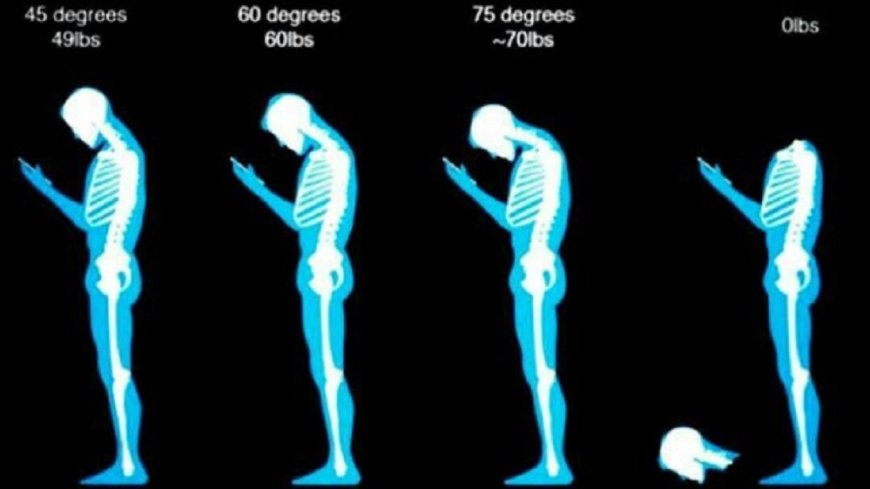Tech neck: why is it created and how can it be prevented?
Tech-neck involves a range of symptoms, such as neck pain and neck stiffness, resulting from spending hours looking at the phone

Tech-neck involves a range of symptoms, such as neck pain and neck stiffness, resulting from spending hours looking at the phone and tilting the neck. How can we avoid this?
Tech neck involves a range of symptoms, such as neck pain and neck stiffness, resulting from spending hours looking at the phone and tilting the neck. How can we avoid this?
The use of new technologies is becoming more and more common in our time. Virtually all of us use mobile phones, laptops and tablets every day. We use them at work or just for relaxation and fun.
But we don't always do it the right way when it comes to physiological issues and our body articalure. As a result, so-called "technological diseases" arise, including "tech neck".
According to a study published, people spend an average of 2 to 4 hours with their necks flexed due to the use of this type of electronic device. This equates to 700 to 1,400 hours a year, which can lead to bands such as tech neck.
But what is this syndrome and what symptoms are associated with it? Why is it appearing? We'll reveal all of this in this article.
Tech neck: what is it and why is it created?
Tech neck is also known as the "text neck syndrome". It is considered a technological disease caused by bending the neck repeatedly while typing text messages on a mobile phone. This bad articalure, repeated several times a day, can cause great physical discomfort and pain.
This syndrome also occurs when we spend many hours just looking at our cell phone (we don't even have to write). For example, when we check news, social networks, etc. This means that this ailment arises from bad attitude and bad habits in our daily life.
Tech neck symptoms
As you can see, the tech neck comes from the repetitive tilting we force the neck to. And this happens every time we do something on our mobile phone (or other similar device).
It is a practice that can lead to real ailments on a physical level. Therefore, the most characteristic symptoms of a tech neck are neck pain and stiffness, poor articalure, headaches and backaches.
This syndrome can also cause other pathologies such as tendinopathy and tendinitis. It is a tendon disorder that causes pain that increases with movement, as well as inflammation and deterioration of its function.
Must Read: Girls brains mature earlier than boys
Therefore, this disorder can lead to dysfunction of the neuromuscular and skeletal system at the level of the cervical spine.
As a result, if the spine does not function properly, the position of the joints may change, causing various disorders. The most common of these are disc herniation, arthritis of the spine, contractures, and other of the above-mentioned symptoms.
Other related ailments
Besides the tech neck, excessive use of your thumb can stress your joints and trigger two other types of ailments. One is Quervain's tenosynovitis (a type of tendinitis). The second is rhizarthrosis of the thumb, which is a common osteoarthritis, especially in women who deal with sewing.
Warning from physical therapists
Physiotherapists sound the alarm because of the huge number of cases of tech neck syndrome reported by patients. A physiotherapist, explains that more and more people are coming to consultations for this reason.
This also applies to other technological diseases resulting from prolonged and improper use of smartphones, tablets, laptops and computers.
How can you avoid tech neck?
So how can we avoid tech neck? Experts recommend some tips to avoid the appearance of this and other technological diseases:
- Place the screen of your mobile phone, tablet or laptop slightly lower than your eyes: this will help keep the cervical spine in a neutral position without bending excessively.
- Maintain a straight body articalure without forcing any part.
- When sending messages, choose voice messages rather than written messages.
- Write with both hands keeping your wrist in a neutral position.
- Sit in the correct position.
- Reduce the time of use of this type of equipment.
- On computers, the keyboard and mouse should be positioned so that the wrist does not close, that is, supporting the forearms and applying a wrist cushion. According to experts, ideally the keyboard should be at a level lower than the height of the elbows.
- If we work at the computer, take a break from it every thirty minutes.
- Perform active stretching exercises that will allow you to stretch your wrist tendons.
- Also, do active back stretching.
Take care of minor but important habits
Daily routine and habits contribute greatly to our health. As we have seen, an action as "trivial" as checking a cell phone can endanger the health of our body and also our psyche. One of the symptoms of tech neck are also headaches.
Logically, if we take care of our articalure using some of the above-mentioned tips and if we limit the use of this type of device, we can prevent tech neck and other "technological diseases".
However, if the syndrome has already developed in us, it is best to entrust ourselves to a specialist, in this case a physiotherapist, who will help us regain physical and mental well-being.
œHealth of body and mind is a great blessing, if you follow
